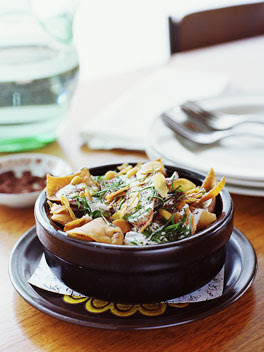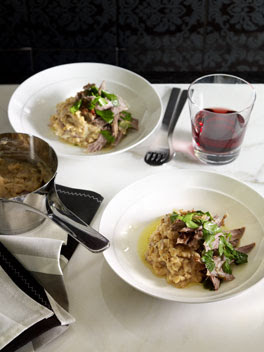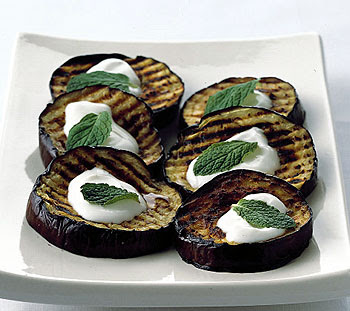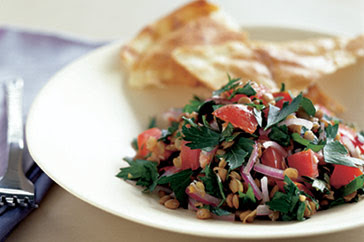 Learn the ABCs & tips of cooking with these taste-enhancing ingredients of herbs & spices
Learn the ABCs & tips of cooking with these taste-enhancing ingredients of herbs & spicesFresh herbs are increasingly accessible all year in large supermarkets, produce markets and specialty stores. Look for moist (but not wet), fresh-looking herbs without drooping leaves or black spots. Fresh herbs are usually chopped to release the flavor before being added to a dish, but dried herbs add excellent flavors to dishes, too. In most instances, a teaspoon of dried herb can be used in place of a tablespoon of a chopped fresh herb—which translates to one-third the amount. It’s a good idea to rub the dried herb between your fingertips before adding it to the dish to help release the herb’s essential oils and flavors. Store dried herbs in their containers, in a cool, dark cupboard, away from the warmth of the stove.
Like dried herbs, spices should be stored in a cool, dark cupboard. Whole, unground spices (such as cloves, nutmeg, peppercorns, coriander and anise) will keep indefinitely. But write the date on jars of ground spices when you open them and be ruthless: Toss those that have been open for a year. If you won’t be using a spice often, buy it in small quantities.
PRESERVING FRESH HERBS: Most fresh herbs can be dried or frozen and used later, with little loss of flavor or aroma. Cilantro is an exception.
TO DRY HERBS: Tie the washed herbs in a bunch at the stem end and hang them, stem ends up, in a warm, dry, well-ventilated section of the kitchen or pantry. Or you can dry them by laying them on a screen and leaving them in a dry, well-ventilated place, indoors or out (protect them from morning dew and evening moisture). Depending on the size and type of herb, it will dry in one to two weeks. Make sure the herbs are completely dry before storing them in a glass or rigid plastic container. If not completely dry, mold may grow.
TO FREEZE HERBS: Dill, parsley, chervil and fennel freeze well.Wash and dry them thoroughly. Discard large stems. Put the herbs in an airtight, rigid plastic container and freeze them. Date the container and use the herbs within a year, using them as you would fresh herbs (no need to defrost). Basil also freezes beautifully and many people like to make and freeze huge amounts of basil pesto when basil is at its best. At the least, purée the basil with olive oil and a little salt before freezing it.
HERBSBASIL: Sweet and aromatic with a faint licorice flavor, basil is found most often in Italian and Mediterranean cooking but is also important in Thai cooking. Its marriage with tomatoes is legendary, and its presence in pesto imperative. Basil may have large or small leaves and may be green or purplish-red. All sizes and colors are equally aromatic. Fresh basil is easy to find all year long. Store-bought basil that has been washed and packaged is often a good bet. If you buy bunches of basil at a farmer’s market, plan to use them promptly, especially if they are wet from rain. Pluck leaves from stems, then wash and drain them.Dry the leaves in a salad spinner, or wrap in kitchen towels or paper towels. Refrigerate until ready to use. Fresh basil is best for serving with sliced fresh tomatoes and mozzarella cheese, or to top a pizza. You can chop the leaves in the usual way like parsley, but to decrease bruising with the knife, stack several leaves and cut them across in thin strips. Dried basil is usually added to cooked preparations such as tomato sauces, soups and stews.
BAY LEAVES: Bay leaves are also called bay laurel and sweet bay. They are slightly spicy, very aromatic and one of the three herbs used (with parsley and thyme) in a classic bouquet garni. Bay leaves, which are fairly large, grayish-green specimens, are usually sold dried, and are added to stews and other savory dishes. They should be discarded before serving. Turkish leaves are greatly preferable to the Californian variety.
CHERVIL: Chervil is sold both dried and fresh and adds a light anise flavor to dishes such as cream soups, dressings and sauces. Chervil leaves are lacy and pale green.
CHIVES: Long, green and grassy-looking, chives are a member of the onion family and are available fresh all year long. Freeze-dried chives are not as flavorful as fresh. Chives’ mild onion flavor is delicious in salads and sprinkled on top of chilled soups or mixed into creamy dips and spreads.
CILANTRO/FRESH CORIANDER: Fresh cilantro resembles flat-leaf parsley and is also called fresh coriander and even Chinese parsley. Cilantro finds its way into Mexican, Indian, Asian, North African and Caribbean cooking, where the roots, stems and leaves are often used. Some call cilantro the love-it-or-hate-it herb. Its distinctive, pungent flavor is easy to discern in salsa and other uncooked preparations. It is less powerful when cooked. Cilantro has little flavor when dried. Coriander seeds (page 381) come from the same plant but impart a very different flavor.
DILL WEED: Fragrant, fresh dill has a sharp lemony flavor; dried dill imparts a similar flavor. Dill weed is used in German, Scandinavian and Middle Eastern cooking often with fish or lamb. It’s very good with potato soups and rice salad as well as with cream cheese for a spread. Greeks use it to flavor stuffed grape leaves. See also dill seed: same plant, very different flavor.
LEMONGRASS: Lemongrass is a pale green stalk with a bulbous base. Only this base is used to infuse dishes with a lovely lemon flavor. Lemongrass is becoming more available as Thai and Vietnamese restaurants become more common, creating a desire among adventurous home cooks to try recipes from those countries.
LEMON THYME: A member of the thyme family, this herb has tiny green leaves and a subtle but recognizable lemony scent and flavor. It is used with meat and fish, as well as salads. Lemon thyme is only available fresh.
MARJORAM: Sometimes called sweet marjoram, it is sold both fresh and dried. Its flavor somewhat resembles oregano and it may be used in place of it in many dishes. Fresh marjoram leaves are small and grayish-green.
MINT: Mint is one of the most common and recognizable herbs; it is also the easiest to grow and can often take over a garden. Mint’s cool, fresh flavor adds to lemonade, iced tea, mint juleps, desserts, chocolate and lamb dishes. It is also used very often for garnish. Mint is easy to buy fresh, but spearmint is also sold dried.
OREGANO: Oregano is most readily associated with Italian, Greek and Mexican cooking and blends well with meat, vegetables and legumes. It has a pungent flavor and aroma and is available both fresh and dried. Fresh oregano has medium-sized dark green leaves.
PARSLEY: Whether curly- or flat-leafed, parsley is our most common herb, but is much more than just a finishing sprig. Parsley, with bay leaves and thyme, makes up traditional bouquet garni, herb flavoring for long-simmering pot roasts and rich stews. Parsley, with lemon juice and a little bulgur wheat, makes tabbouleh, the delicious Middle-Eastern salad. Mixed with garlic and butter it flavors baked snails; with garlic, clams and olive oil it is a great sauce for pasta. Parsley again teams with garlic in Argentinian chimichurri sauce, served with beef and chicken. Parsley is nearly always best used fresh, although it is sold dried.
ROSEMARY: Rosemary is characteristically found in Mediterranean cooking, where its spicy flavor and fragrant scent lend themselves to roast chicken and lamb. Rosemary and olives add delicious flavor to bread. But rosemary also has an unexpected sweet side. Rosemary is sold both fresh and dried. If purchased fresh, pull the leaves off the hard stems before chopping them.
SAGE: Sage’s fuzzy gray-green leaves are easy to spot among the fresh herbs; its strong, slightly musty flavor is easy to recognize in pork sausage, sage and onion stuffing and other meat and poultry dishes. Dried sage comes in two forms: cut sage, when you want the leaf to show, and ground, which is closer to a powder. Ground sage loses its flavor much more quickly than do the leaves.
SAVORY: The small pointed green leaves of the savory plant add pleasantly sharp flavor to egg and fish dishes, lentils and beans and meats. Savory is also found in spice blends of the Mediterranean, including herbes de Provence. Savory is available fresh and dried and is often called summer savory.
TARRAGON: Pleasantly aromatic and tasting of licorice, tarragon’s slender and somewhat spiky dark green leaves make it easily recognizable.Tarragon is used extensively in French cooking, in béarnaise sauce, with fish and with chicken (poulet à l’estragon) and is a common flavoring for vinegar. Tarragon is available both fresh and dried.
THYME: Thyme is one of the three herbs found in a classic bouquet garni (with bay leaves and parsley), a bundle of herbs used to flavor soups, stews and stocks. Its slightly strong pungent taste and spicy aroma are also frequently used to flavor chicken and other poultry dishes, including traditional bread stuffing. Thyme, readily available both fresh and dried, has tiny, dark green leaves.
SPICESALLSPICE: Allspice is sold as whole berries or ground. It comes from the seed of a tree indigenous to the Western Hemisphere, which makes it unusual in the world of spices, most of which originate in Asia. It earned the name “allspice” because its flavor represents a combination of cinnamon, cloves and nutmeg. Allspice is used in fruit desserts, chutneys and pickles (it’s a frequent ingredient in pickling spices). Allspice is essential in Jamaican jerk seasoning.
ANISE SEEDS: Anise tastes very similar to licorice, although the two are unrelated botanically. Anise is used to flavor cookies, cakes, fruit desserts, breads, stews and meat dishes. It is sold whole or ground.
ANNATTO SEEDS: Also called achiote, annatto are rusty red seeds with musky flavor. They are used mainly in Mexican and Southwestern cooking and impart a red-to-yellow color to foods. Annatto seeds are available whole or ground.
CARAWAY SEEDS: Caraway seeds taste sweet and nutty and are used to flavor breads, cheeses, coleslaw, sauerkraut, sausages and vegetable dishes. They are one of the oldest known spices and as such are integral to European and Asian cooking. Caraway seeds are available either whole or ground.
CARDAMOM: Cardamom is the dried, unripened fruit of a perennial. Enclosed in green, white or black pods are a dozen or so tiny, brownish-black aromatic seeds. Cardamom is available in the pod or ground, and is widely used in Scandinavian, Indian and Arab cuisines. In Scandinavia it is more popular than cinnamon for baked goods. Cardamom is an essential ingredient in dishes as diverse as Indian garam masala seasoning and Swedish meatballs and breads. The Arabs often flavor coffee with cardamom, a drink considered a symbol of hospitality. Cardamom is the third most costly spice—after saffron and vanilla.
CAYENNE: Cayenne, more properly called ground red pepper, is ground red chiles and adds noticeably spicy heat to dishes such as chilies and curries and in spice rubs for meats to be grilled. Use it sparingly at first. Cayenne is only available ground.
CELERY SEEDS: Celery seeds are tiny, light-brown seeds that provide celery flavor to soups, breads, sauces, stuffings, eggs and vegetables. However, they do not taste identical to celery; hints of nutmeg and parsley are detected in dishes seasoned with celery seeds. Celery seeds are usually sold whole, although they are available ground. Celery salt is a mixture of finely ground celery seeds and salt.
CHILI POWDER: Chili powder is deep red, ground seasoning mix that combines chiles, spices, herbs, garlic and salt. It may be mild, somewhat hot or fiery hot. Chili powder is used to flavor chilies and other Mexican and Southwestern dishes.
CINNAMON: Cinnamon, native to Sri Lanka, is a treasured spice used around the world to flavor desserts, baked goods and some meat dishes. Its warm, sweet flavor is recognizable to nearly everyone. Cinnamon is sold in rolled sticks in various lengths (part of the actual bark of a plant) or ground.
CLOVES: Cloves are the buds of furled flowers of an evergreen tree. The name comes from the French “clou,” meaning nail, which whole cloves resemble.We think of them as something to stud ham with and as flavoring for cookies, but cloves are also an important flavor factor in tomato ketchup and Worcestershire sauce. Cloves are an important ingredient in the spice blends of Sri Lanka, North India (garam masala) and the Caribbean. Cloves are also use in Chinese and German cooking.
CORIANDER SEEDS: Coriander seeds are aromatic and sweet and are used extensively in North African, Mediterranean, Mexican, Indian and Southeast Asian cuisines.Whole coriander seeds are often found in pickling spice. Ground coriander is found in many spice blends including chili powder, garam masala, curry powder and Ethiopian berbere. It is often included in hot dogs and other sausages, as well as in pastries.
CUMIN: Cumin imparts a strong, aromatic, somewhat bitter flavor to foods. It is an essential ingredient in most chili powders and can also be found in curries, vegetable dishes, breads, soups and pickles. Cumin is available whole or ground.
CURRY POWDER: Curry powder is a blend of several spices and is used to flavor many dishes, particularly those referred to as curries inspired by Indian cooking. Not all curry powder blends are identical, but most commercially available in the United States include ginger, cumin, turmeric, black pepper, cayenne and coriander. Look in the Thai foods section of your market for red, yellow and green curry bases.
DILL SEED: Dill seed is used most often as a pickling spice, although it is also popular in breads and potato and vegetable dishes. Dill seeds are sold whole or ground.
FENNEL SEEDS: Fennel seeds taste of licorice and are used to flavor breads, fish dishes, soups and sweet pickles.They are available whole or ground. Fennel is the dominant flavor in Italian sausage.
GINGER: Ginger is sold fresh or ground. When fresh, it comes as gingerroot, a knobby, woody root (actually a rhizome) that is peeled and grated, sliced or chopped before being used. Ginger is used to flavor both savory and sweet dishes, including meat, poultry, fish, curries, winter squash, carrots and sweet potatoes. Ginger is essential to many Asian, Indian and African dishes. It is also used to flavor fruit, syrups and desserts. Crystallized ginger is candied ginger; it may be chopped and added to gingerbread or crème brulée, or enjoyed on its own.
JUNIPER BERRIES: Juniper berries are available both dried and fresh, although most recipes call for dried berries as the fresh berries are exceptionally pungent. Dried berries must be crushed before they are added to preparations. As the berries of an evergreen shrub, they taste somewhat of pine. Their strong flavor blends well with game and game birds, and they are used in the production of gin. Juniper berries are available whole.
MACE: Mace is the reddish-orange, lacy covering (called an aril) of a nutmeg seed and is usually ground into powder, although it is sometimes available whole. Mace imparts a nutmeg-cinnamon flavor to poultry and fish dishes, pickles, cakes, custard and puddings.
MUSTARD SEEDS: The seeds of the mustard plant are sold whole or ground into powder and are used to flavor coleslaw, curry, dressings and pickles, to say nothing of the yellow mustard that we slather on hot dogs. The most common mustard seeds are white, yellow or brown. Black mustard seeds, which are more pungent, are used in Indian cooking. White mustard seeds are used to make commercially prepared American mustards and some English mustards. Brown mustard seeds are used for Dijon mustards.
NUTMEG: Nutmeg is a favorite among spices and finds its way into any number of baked goods, sauces, fruit desserts and puddings. Eggnog is not official until it is topped with a sprinkling of nutmeg. Nutmeg is sold ground or whole, but for the best flavor it is advisable to buy the whole seed and grate it as needed. It grates very easily and can even be scraped with a small paring knife. Whole nutmegs keep their flavor almost indefinitely so grating it as you need it eliminates the pressure to toss opened ground spices after a year.
PAPRIKA: To those who know, paprika is not just a pretty red powder sprinkled on food as decoration. It is serious spice. Hungarians, for example, use lavish amount of paprika in many national favorites, including goulash soup and chicken paprikash. And paprika is used in seasoning blends for barbecue and chili. It is also essential to the cooking of India, Morocco and the Middle East. Paprika is made by grinding dried spicy red peppers to powder. Hungarian rose paprika ranges from mild and full-bodied to hot and spicy; Spanish paprika, ground from dried pimientos, is always mild.
PEPPER: Pepper is our most popular spice and accounts for 25% of the world’s spice trade. The most common pepper is ground from black peppercorns, although white, red and dried green peppercorns are available and are often sold as a mixture. Some recipes specify white pepper because it does not add dark specks to the food. Although pepper is sold already ground, it tastes best when ground in a peppermill just before using. Pink peppercorns are dried berries of a rose plant and not true peppercorns.
POPPY SEEDS: Tiny slate-blue poppy seeds have a crunchy texture and provide a sweet, nutty topping to breads and bagels, and a crunchy addition to cookies and poundcakes. The seeds are also used in noodle dishes in Jewish, German and Slavic cooking.Ground, often after being toasted, and mixed with sugar and sometimes nuts, poppy seeds are used as a filling for strudel and Danish pastries. Poppy seeds are available whole, and also canned as a pastry filling.
SAFFRON: Saffron, the threadlike stigmas from a variety of Spanish crocus, is the world’s most expensive spice. The stigmas must be plucked from the flowers by hand—and it takes 225,000 of them to make 1 pound of saffron. Saffron imparts a strong aroma and distinctive bitter honey-like taste to food as well as a deep yellow color. It is used for paella, for the rich French fish soup called bouillabaisse, and for chicken and fish dishes in Moroccan cooking. Saffron is also used in some sweet pastries. Saffron is sold whole and ground.Whole is the better way. A few stamens are usually soaked for a few minutes in warm water before being added to the dish.
SESAME SEEDS: Also known as benne seeds, sesame seeds were introduced to the Americas by African slaves. Sesame seeds are integral to African, Asian and Indian cooking and are used in the United States in baked goods. Favored for their nutty flavor, sesame seeds are also used to make the candy called halva. The white variety of sesame seed is the most common.
TURMERIC: A member of the ginger family, turmeric is ground into a bright yellow-orange powder and is used to flavor curries as well as vegetable, egg and fish dishes. Turmeric is a significant ingredient in curry powder and prepared mustard, and is also used in pickling. It gives food a pleasantly bitter, mild flavor.
VANILLA: Vanilla is a familiar and popular flavor, used in many desserts, confections, baked goods, beverages and some savory preparations. The long, thin pod is the fruit of an orchid that is the only one of more than 20,000 orchid varieties that bears anything edible. The long process of picking and curing the beans accounts for the high cost of vanilla beans and pure vanilla extract. Most of the vanilla beans grown today come from Mexico, Tahiti or, perhaps the best, from Madagascar, an island off the coast of Africa. Vanilla beans are richer tasting than vanilla extract, but extract can nearly always be used in recipes calling for the beans. Pure vanilla extract is far more flavorful than imitation vanilla extract. Vanilla is the second most expensive spice after saffron.
Save and share Tips for Cooking with Herbs and SpicesWant to share this post with your family and friends? Click the button below to send them an email or save this to your favorite social network.































